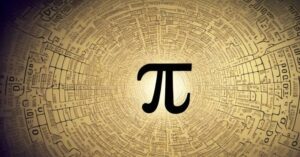Introduction
Pi (π) is one of the most well-known mathematical constants in the world, symbolizing the ratio of a circle’s circumference to its diameter. This constant appears in various fields of science and engineering, making it a cornerstone in the study of mathematics. While commonly approximated as 3.14159, the digits of pi extend infinitely without repeating, making it a subject of intrigue and continuous study.
The Historical Journey of Pi
The concept of pi has been known to humanity for thousands of years. Ancient civilizations, including the Egyptians and Babylonians, made early estimates of pi, using geometrical methods to approximate the value. The Greek mathematician Archimedes is credited with developing a more accurate method for calculating pi by inscribing and circumscribing polygons around a circle.
Pi in Modern Mathematics
In modern times, pi is calculated using advanced algorithms and computational power. The search for more digits of pi is not merely academic; it has practical applications in fields such as numerical analysis, cryptography, and quantum computing. The most recent records involve calculating pi to trillions of digits, showcasing the capabilities of contemporary supercomputers.
3.14159u: The Mystique of Pi’s Digits
The digits of pi are a subject of fascination and analysis. The sequence 3.14159u represents the first six digits of pi, but beyond this lies an infinite string of numbers. Mathematicians and enthusiasts often memorize these digits as a mental exercise, and there are even competitions dedicated to reciting pi from memory.
Applications of Pi in Engineering and Science
Pi plays a crucial role in various scientific and engineering disciplines. In physics, it appears in formulas describing wave motion, heat transfer, and the behavior of particles at atomic and subatomic levels. In engineering, pi is essential in designing anything circular, from wheels and gears to satellites and bridges.
The Cultural Impact of Pi
Pi has also permeated popular culture, symbolizing the beauty and mystery of mathematics. Pi Day, celebrated on March 14th (3/14), is an occasion for math enthusiasts to revel in the wonders of this constant. Schools and universities around the world host events, competitions, and lectures to mark this day.
Exploring the Infinite: Mathematical Curiosities
One of the most intriguing aspects of pi is its infinite, non-repeating decimal expansion. This characteristic raises questions about randomness and patterns within the digits of pi. Researchers have used statistical tools to analyze the distribution of digits, searching for hidden structures or anomalies.
Pi and Technology
In the digital age, pi’s infinite nature serves as a benchmark for testing computational algorithms and hardware. Calculating pi to millions or billions of digits pushes the limits of processors and memory, providing valuable data for improving technology. Moreover, the precision required in modern engineering and science often relies on high-accuracy values of pi.
The Beauty of Mathematical Constants
Mathematical constants like pi remind us of the inherent order and symmetry in the universe. They connect abstract mathematical theories with real-world phenomena, highlighting the elegance of mathematical relationships. Pi, in particular, illustrates how a simple ratio can unlock a deeper understanding of the natural world.
Pi is more than just a number; it is a symbol of mathematical exploration and human curiosity. From ancient approximations to modern-day supercomputing feats, the journey to understand pi has driven advancements in various fields. The sequence 3.14159u marks the beginning of this infinite voyage, inviting us to delve deeper into the mysteries it holds. As we continue to uncover the secrets of pi, we celebrate not only the number itself but also the boundless potential of human ingenuity.
FAQs
What is pi (π)?

Pi (π) is a mathematical constant representing the ratio of a circle’s circumference to its diameter, approximately equal to 3.14159.
Why is pi important in mathematics?
Pi is essential for calculations involving circles and appears in various mathematical and scientific formulas, making it fundamental to fields like geometry, trigonometry, and physics.
How is pi used in modern technology?
Pi is used to test computational algorithms and hardware, and its precision is crucial for engineering designs and scientific research.
What is Pi Day, and how is it celebrated?
Pi Day is celebrated on March 14th (3/14) to honor the mathematical constant pi. It involves educational activities, competitions, and events dedicated to mathematics.
Are the digits of pi truly random?
While the digits of pi appear random and non-repeating, researchers continue to study their distribution to uncover any hidden patterns or structures.
This content covers the significance of pi, its historical journey, applications, and cultural impact while integrating the subheading 3.14159u.
The Infinite Nature of Pi
One of the most intriguing aspects of pi is its infinite, non-repeating decimal expansion. Mathematicians have long been fascinated by the idea that, despite its simple definition, the digits of pi go on forever without forming a predictable pattern. This characteristic raises several questions about randomness and the underlying nature of mathematics.
3.14159u: A Glimpse into Infinity
The sequence 3.14159u represents just a tiny glimpse into the vast, unending sequence of digits that make up pi. This infiniteness suggests that every possible number combination exists somewhere in pi’s digits, a concept that has both mathematical and philosophical implications.
Pi and the Search for Patterns
Despite the seemingly random nature of pi’s digits, researchers have used statistical tools to analyze their distribution. This work has applications in fields like cryptography, where understanding randomness and pattern detection is crucial. The quest to find order in the chaos of pi’s digits continues to be a compelling area of mathematical research.
Pi in the Natural World
Pi is not just a mathematical abstraction; it appears in various natural phenomena. For instance, the patterns of waves, the shapes of planets, and the orbits of celestial bodies all involve calculations using pi. This ubiquitous presence underscores the deep connection between mathematical constants and the physical universe.
Pi in Art and Literature
The influence of pi extends beyond science and mathematics into the realms of art and literature. Artists have used the concept of pi to explore themes of infinity and the unknown. In literature, pi often symbolizes mystery and complexity, appearing in works that delve into the nature of reality and the human experience.
Educational Significance of Pi
Understanding pi and its applications is a fundamental part of mathematics education. Teaching students about pi helps them grasp the importance of ratios and geometry, fostering a deeper appreciation for the interconnectedness of mathematical concepts. Educational programs and activities centered around pi can inspire a lifelong interest in mathematics.
314159u: The Digit Hunters
There is a dedicated community of “digit hunters” who memorize and recite the digits of pi. These enthusiasts often participate in competitions, showcasing their memory skills by reciting thousands of digits. The practice of memorizing pi serves as a mental exercise and a way to engage with mathematics in a unique and personal manner.
Pi and Computational Mathematics
The calculation of pi to millions or billions of digits serves as a benchmark for testing the capabilities of computers and algorithms. These calculations are not just theoretical exercises; they provide valuable data for improving computational methods and technologies. The pursuit of more digits of pi is a testament to the synergy between mathematics and computer science.
The Role of Pi in Engineering
In engineering, precision is paramount, and pi is essential for designing and analyzing systems involving circular or spherical components. Whether it’s constructing bridges, designing gears, or launching satellites, engineers rely on the accuracy of pi to ensure the functionality and safety of their designs.
Celebrating Pi: Global Impact
Pi Day has become a global celebration, with schools, universities, and math enthusiasts participating in various activities. From pie-eating contests to math challenges, Pi Day brings people together to appreciate the beauty and importance of mathematics. This celebration highlights how a mathematical constant can inspire creativity and community.
Conclusion
Pi, represented by the sequence 314159u and beyond, is more than a mere number; it is a gateway to understanding the universe’s fundamental principles. Its infinite nature, applications in various fields, and cultural significance make pi a subject of perpetual fascination. As we continue to explore the depths of pi, we not only uncover more about mathematics but also about the boundless potential of human curiosity and intellect.
FAQs
What is the significance of pi’s infinite digits?
The infinite, non-repeating digits of pi illustrate the complexity and richness of mathematical constants, providing endless opportunities for study and application.
How is pi used in everyday life?
Pi is used in various everyday calculations, including determining the circumference and area of circles, in engineering designs, and in understanding natural patterns.
What are some famous pi-related challenges?
Famous pi-related challenges include memorizing and reciting its digits, and Pi Day competitions that involve math problems and creative activities centered around pi.
Why do we celebrate Pi Day on March 14th?
Pi Day is celebrated on March 14th because the date (3/14) represents the first three significant digits of pi (3.14).
How do advancements in computing impact our understanding of pi?
Advances in computing allow us to calculate pi to more digits, testing the limits of our technology and enhancing our understanding of computational mathematics and numerical precision.


